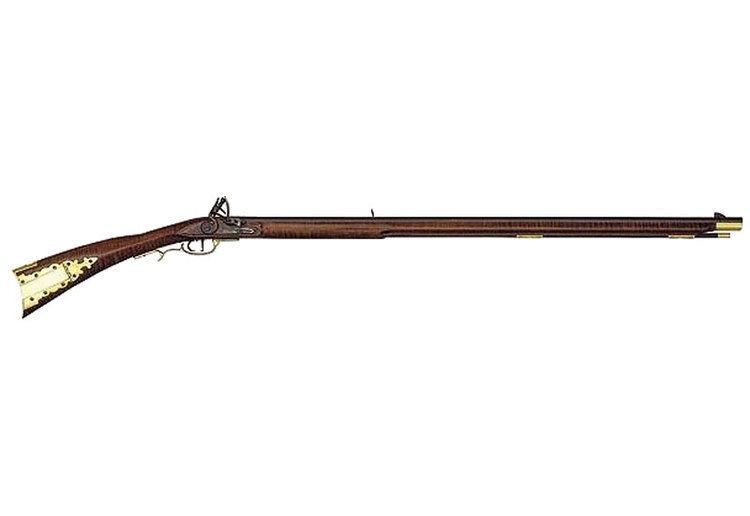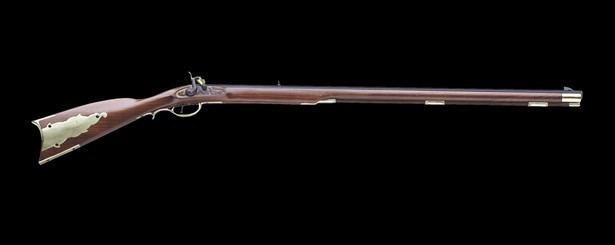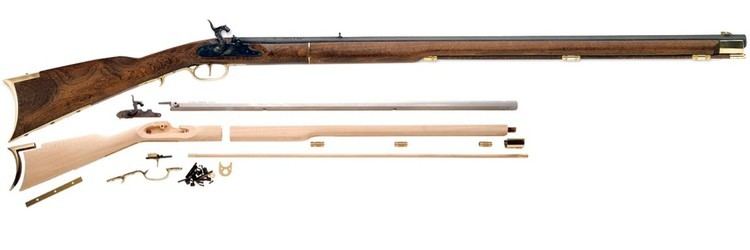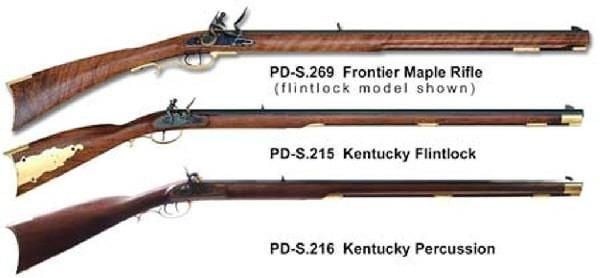Designed c. 1700s | In service c.1700-c.1900 | |
 | ||
Type muzzleloading long rifle | ||
Ruger gp100 22 long rifle
The long rifle, also known as longrifle, Kentucky rifle, or Pennsylvania rifle, was one of the first commonly used rifles for hunting and warfare. It is characterized by an unusually long barrel, which is widely believed to be a largely unique development of American rifles that was uncommon in European rifles of the same period.
Contents
- Ruger gp100 22 long rifle
- American flintlock long rifle loading and shooting america s first rifle
- Origins
- Evolution
- Characteristics
- Decline and rebirth
- In popular culture
- References

The longrifle is an early example of a firearm using rifling, spiral grooves in the bore. This gave the projectile, commonly a round lead ball, a spiraling motion, increasing the stability of the trajectory. A more stable trajectory meant dramatically improved accuracy over the more commonly available smooth bore muskets also used in the period. Rifled firearms saw their first major combat use in the American colonies during the French and Indian War, and later the American Revolution in the eighteenth century.

Until the development of the Minié ball in the middle of the 19th century, the main disadvantages of a rifle compared to a musket were a slower reload time due to the use of a tighter fitting lead ball and greater susceptibility to the fouling of the bore after prolonged use - such fouling would eventually prevent loading altogether, rendering the weapon useless until thoroughly cleaned. The adoption of the Minié ball essentially nullified these disadvantages and allowed the rifle to completely replace the musket.

The longrifle was made popular by German gunsmiths who immigrated to America, bringing with them the technology of rifling from where it originated. The accuracy achieved by the longrifle made it an ideal tool for hunting wildlife for food in colonial America.

The American Longrifle, more commonly, but less correctly, known as the 'Kentucky rifle', was described by Captain John G. W. Dillin in the dedication to his seminal 1924 book, The Kentucky Rifle:

From a flat bar of soft iron, hand forged into a gun barrel; laboriously bored and rifled with crude tools; fitted with a stock hewn from a maple tree in the neighboring forest; and supplied with a lock hammered to shape on the anvil; an unknown smith, in a shop long since silent, fashioned a rifle which changed the whole course of world history; made possible the settlement of a continent; and ultimately freed our country of foreign domination. Light in weight; graceful in line; economical in consumption of powder and lead; fatally precise; distinctly American; it sprang into immediate popularity; and for a hundred years was a model often slightly varied but never radically changed.

American flintlock long rifle loading and shooting america s first rifle
Origins
The longrifle was developed on the American frontier in south eastern Pennsylvania, in the early 1700s. It continued to be developed technically and artistically until it passed out of fashion in the 19th century. The longrifle was the product of German gunsmiths who immigrated to new settlements in south eastern Pennsylvania in the early 1700s, and later in Virginia and other territories. Tax records from these locales indicate the dates these gunsmiths were in business. Strong pockets of longrifle use and manufacture continued in the Appalachian Mountains of Virginia, Tennessee, Kentucky, Ohio and North Carolina well into the 20th century as a practical and efficient firearm for those rural segments of the nation. Longrifles could be made entirely by hand and hand-operated tooling, in a frontier setting.
Initially the weapon of choice on the frontier was the smooth bore musket, or trade gun, built in factories in England and France and shipped to the colonies for purchase. Gradually, longrifles became more popular due to their longer effective range. While the smooth bore musket had an effective range of less than 100 yards, a rifleman could hit a man-sized target at a range of 200 yards or more. The price for this accuracy was longer reloading time. While the musket could be reloaded in approximately 20 seconds, the longrifle required more time for the average hunter.
In Pennsylvania, the earliest gunsmiths that can be documented are Robert Baker and Martin Meylin. Robert Baker formed a partnership with his son, Caleb and on August 15, 1719 erected a gun boring mill on Pequea Creek. In the tax records of Berks County, Pennsylvania, there were several gunsmiths plying their trade along the banks of the Wyomissing Creek.
Martin Meylin's Gunshop was built in 1719, and it is here that the Mennonite gunsmith of Swiss-German heritage crafted some of the earliest, and possibly the first, Pennsylvania Rifles. No single rifle has been found to date to be signed by Martin Meylin. Two have been attributed to him- one in the Lancaster Historical Society has been found to be a European musket of a later date and the other with a date of 1705 has been found to be a forgery- the Mylins didn't arrive in America until 1710. The Martin Meylin Gunshop still stands today in Willow Street, Pennsylvania, on Long Rifle Road. An archaeological dig performed in 2005 by Millersville University around the so-called Mylin gunshop found no evidence of gunmaking activity among the thousands of artifacts found - only blacksmithing artifacts were found. The Lancaster County Historical Society has an original Pennsylvania Long Rifle smithed by Meylin that was passed down within the family for seven generations before being donated to the society in the middle of the twentieth century. This particular rifle was analyzed and the barrel removed during the Lancaster Long Rifle Exhibit at Landis Valley Farm Museum, Lancaster, Pennsylvania in 2005. The six experts on hand found the barrel was European and the stock itself dated from a later period than 1710-1750. The initials on the barrel - "MM" were found to be added later than any other part of the gun, therefore it was concluded that the rifle in the Lancster County Historical Society could not have been made by either son or father named Martin Mylin. A document describing the history of Meylin, the Gunshop, and archeology of the shop is available online from Millersville University.
Some historians have written that the role of Martin Meylin as one of the earliest gunsmiths in Lancaster is not clear. The argument is that the will of Martin Meylin, Sr. makes no mention of gunsmith items while the will of Martin Meylin, Jr. is replete with gunsmith items, and thus the reference to Meylin as a gunsmith is more properly placed on the son. In any case, no rifle has been found to be positively attributed to any Mylin.
There is documentation stating that the first high quality 'Kentucky rifles' were from a gunsmith named Jacob Dickert, who moved with his family from Germany to Berks County, Pennsylvania in 1740. The name 'Dickert Rifle' was considered a 'brand name' and the name 'Kentucky rifle' was not coined until much later in history (circa 1820s) and became the more broadly accepted nickname of this rifle. The reason for this is primarily because Dickert made rifles for the Continental Army and later had a contract dated 1792 to furnish rifles to the United States Army. There are internet references to a "Deckhard or Deckard Rifle", which is inaccurate, as there are no borough, township, or city tax records to support this name at that period of time and/or location.
Among documented working rifle makers are Adam Haymaker, who had a thriving trade in the northern Shenandoah Valley of Virginia, the Moravian gunshops at Christian's Spring in Pennsylvania, John Frederick Klette of Stevensburg, Virginia, and in the Salem area of North Carolina. All three areas were busy and productive centers of rifle making by the 1750s. The Great Wagon Road was a bustling frontier thoroughfare, and rifle shops traced this same route - from eastern Pennsylvania, down the Shenandoah Valley, and spilling into both the Cumberland Gap into Kentucky and the Yadkin River (Salem) area of North Carolina.
The settlers of western Virginia (Kentucky), Tennessee, and North Carolina soon gained a reputation for hardy independence and rifle marksmanship as a way of life, further reinforced by the performance of riflemen in the American Revolution, especially Morgan's Riflemen, who were pivotal in both the Battle of Saratoga and the Battle of Cowpens, as well as the War of 1812. In that war, the long rifle gained its more famous nickname the Kentucky Rifle, after a popular song "The Hunters of Kentucky," about Andrew Jackson and his victory at the Battle of New Orleans. The long rifle also was used by the Texans in their War for Independence from Mexico.
The reason for the American rifle's characteristic long barrel is a matter of adaptation to the new world by the German immigrant gunsmiths. The German gunsmiths working in America were very familiar with German rifles, which seldom had barrels longer than 30 in., and were large caliber rifles using large amounts of lead. The new world forests were vast and required hunters to carry more of their supplies with them. The smaller caliber rifles gave them more ammunition and reduced the amount of weight they needed to carry on a hunt. The longer barrel gave the black powder more time to burn, increasing the muzzle velocity and accuracy. A rule of thumb used by some gunsmiths was to make the rifle no longer than the height of a customer's chin because of the necessity of seeing the muzzle while loading. The longer barrel also allowed for finer sighting. By the 1750s it was common to see frontiersmen carrying the new and distinctive style of rifle.
Evolution
In 1792 the US Army began to modify the "Kentucky" rifle, shortening the barrel length to 42 inches in their 1792 contract rifle. The Lewis and Clark expedition carried an even shorter version, 33-36 inches, similar to the Harpers Ferry Model 1803 which began production six months after Lewis paid the arsenal a visit. The Model 1803 resembles what became the 'plains rifle'.
The "plains rifle" or "Hawken rifle" was a shorter, carbine variant. It was popular among mountain men and North American fur trappers in the 19th century. The Hawken brothers (Samuel and Jacob) were one of a number of famous gunsmiths active in St. Louis in the 1830s-1860s. Many renowned gunsmiths such as Horace (H.E.) Dimick and J. P. Gemmer produced powerful and portable "short" long rifles for the Rocky Mountain fur trade, overland exploration, and the transcontinental immigrant trains. The plains rifle combined accuracy with portability in a more compact package than the extreme long guns from which it had evolved. While many plains rifles were built to fire heavy rounds against dangerous game, more were chambered around the .40 calibre range for medium game hunting. "Kentucky" rifles tended to be slimmer and more elegant than the later, more massive, and shorter-barreled Hawken variant rifles. The Hawken rifle evolved from the "Kentucky" rifle for use against larger, more dangerous game encountered in the American West. For firing heavier and larger diameter bullets and heavier powder loads, the barrel wall thickness was necessarily strengthened, and the barrel length of the Hawken was shortened to keep the carrying weight manageable.
Characteristics
Artistically, the longrifle is known for its graceful stock, often made of curly maple, and its ornate decoration, decorative inlays, and an integral, well-made patchbox that was built into the stock. The decorative arts of furniture making, painting, silver smithing, gunsmithing, etc. all took their style cues from the prevailing trends of the day, and as in most things the fashion was set in Paris. Baroque and later rococo motifs found their way into all the decorative arts, and can be seen in the acanthus leaf scroll work so common on 18th century furniture and silver. The best American longrifles have art applied to them that is the equal of any Philadelphia cabinet or silver shop.
Originally rather plain, by the 1770s every surface of the rifle could have applied artwork. An accomplished gunsmith had to be a skilled blacksmith, whitesmith, wood carver, brass and silver founder, engraver, and wood finisher. European shops at the time had significant specialization of the trades, leading to separate tradesmen building each rifle. The American frontier had no such luxury, and quite often only one gunmaker would make the entire rifle, a process almost unheard of in 18th century trade practice. The flintlock action, with its spring mechanism, and single-action trigger, though, was often purchased in bulk by gunsmiths from England, and then fabricated with skill into an elaborate rifle. Early locks were imported but domestic manufacturing of locks increased in America among the more skilled gunsmiths in later years.
To conserve lead on the frontier, smaller calibers were often preferred, ranging often from about .32 to .45 cal. As a rifle became worn from use, with accumulated corrosion from firing black powder causing the bore to enlarge, it was not uncommon to see many rifles re-bored and re-rifled to larger calibers, to keep the rifle shooting accurately. Many copies of historical Kentucky Rifles are seen with a bore of around .50 caliber.
The longrifle is said by modern experts to have a range of 80 to 100 yards. This figure is meant for the average user. A trained, experienced shooter who knows how to take variables into account such as (gunpowder) load, windage, drop, etc. can easily extend the median range of the long rifle to 200-300 yards. In 1778 at the siege of Boonesborough, Kentucky, one of the officers of the combined British/Shawnee assault force was hiding behind a tree. He stuck his head out from behind the tree and was instantly killed by a ball to the forehead fired by Daniel Boone, who was known for always firing the same fixed measure load of black powder in his rifle. This shot was later confirmed by witnesses on both sides and the distance measured at 250 yards. Hitting a target so precisely at that range would probably make the "Kentucky" rifle comparable in total effective (long) range with the later British Baker rifle at 300 to 400 yards.
Although less commonly owned or seen on the frontier, the "Kentucky" rifle style was also used on flintlock pistols during the same era. These pistols were often matched in caliber to a "Kentucky" rifle owned by the same user, to enable firing a common-sized and common-patched round lead ball. With the same graceful stock lines and barrel style, and craftsmanship, they were noticeably slimmer and had a longer rifled barrel with better sights than had been seen on the earlier Colonial style flintlock pistols. Dueling pistol sets in the "Kentucky" rifle style were also made, sometimes in a cased set, for wealthy gentlemen.
Decline and rebirth
By the 20th century, there was little traditional longrifle making left except in isolated pockets in the Appalachian mountains. Few men were left who could entirely build a longrifle. Popular interest in shooting as a sport as well as the sesquicentennial of the United States' independence from Britain in 1925-33 spurred interest in the origins of the 'American Longrifle'. One of the first evidences of this renewed interest was the seminal work in 1924 by Capt. John G.W. Dillin The Kentucky Rifle. Early 20th century pioneers of longrifle culture were Walter Cline, Horace Kephart, Ned Roberts, Red Farris, Hacker Martin, Bill Large, Jack Weichold, Ben Hawkins, D.C. Addicks, L.M. Wolf, Dave Taylor, Win Woods, and Alvin Wagner.
Many men throughout the remainder of the 20th century worked to expand our knowledge of the 'American Longrifle' and how to recreate it in the 18th and 19th century manner. Foremost among these were Joe Kindig Jr, George Shumway, Earl Lanning, Wallace Gusler, John Bivins, Garry Brumfield and many others. In 1965, Wallace Gusler, as the first master of the Gunsmith shop in Colonial Williamsburg, was the first to recreate an 'American Longrifle' in modern times using 18th century tools and techniques. The 1968 film "Gunsmith of Williamsburg" documented the production of his second, all handmade, longrifle. This film has been re-released on DVD and is available from a number of online sources. Since that time, many other makers have trained by these men and many other pioneers of the rebirth of the longrifle culture. The Gunsmith Shop in Colonial Williamsburg under Wallace Gusler and Gary Brumfield produced Dave Wagoner, Jon Laubach, George Suiter, Clay Smith, and Richard Frazier. These are the only men who have emerged from the Gunshop to date who have produced an all handmade rifle. In addition to his influence in his popular series of articles for Rifle Magazine and his involvement with the Museum of Early Southern Decorative Arts (MESDA) John Bivins trained the outstanding gunmakers Jim Chambers and Mark Silver. Then there were other standouts like Earl Lanning, Keith Casteel, Hershel and Frank House, Jack Brooks, Jud Brennon, Ron Ehlert, Robert Harn, Troy Roope and many more. Their work and that of others can be seen in the book: Three Centuries of Tradition: The Renaissance of Custom Sporting Arms in America, published by The Minneapolis Institute of Arts and Scala Publishers, Ltd.
While there have been many great builders over the past 50 years who have helped revive the recreation of the historically correct 'American Longrifle', there are many talented newer builders such as Allen Martin, Eric Kettenburg, Jim Kibler, Mark Wheland, Ken Eckenroth, and others. There are more and more builders all the time as evidenced by AmericanLongrifles.org, a group of forums serving the interests of builders of traditional muzzleloading arms, with over 3000 members including most of the top builders alive today. AmericanLongrifles.org(ALR) was started in 1997 by Mark Elliott at same time that Gordon Barlow was creating the Contemporary Longrifle Association (CLA). The CLA is a membership organization consisting of students, collectors, and artisans producing contemporary (20th century and later) hand made recreations of 'American Longrifles', their accoutrements, and associated arms and crafts of pre-1840 America. The overflow crowds that fill the Lexington,KY Convention Center each August for the CLA annual meeting and show is evidence of the popularity of the contemporary 'American Longrifle' and traditional crafts. There are also large suppliers for muzzleloading supplies such as Dixie Gun Works and Track of the Wolf as proof of the vibrancy of the contemporary longrifle. Then there are the numerous parts suppliers such as Jim Chambers Flintlocks, R.E. Davis, and L&R, for locks; Rice, Rayl, and others for barrels, Dunlap Woodcraft, Tiger Hunt, and Freddie Harrison among others for stock wood. Then there are hundreds of other individual artisans producing small parts and supplies for resale by the like of Track of the Wolf, Dixie Gunworks, Dixons Muzzleloading Shop, Stonewall Creek Outfitters, Tip Curtis, and others.
The recreation of the 'American Longrifle' continues.
